The Evolution of Street Lighting in Raleigh
If you’ve driven down Hillsborough Street at night within the past week or so, you may have noticed some new lighting. What makes this lighting noteworthy is that it is LED (right), as opposed to fluorescent or the more common sodium vapor lamps (left).Â
But before we dive into why this is important, let’s take a look at the history of municipal lighting of streets, buildings, and sidewalks at night.Â
Before There Was Electric LightingÂ
Gas powered lamps first appeared on Fayetteville Street in the late 1850s, and increased in popularity after the Civil War. As far as I know, there are only two local remnants of this era: the converted post in front of Christ Church (above) and an iron stub on the corner of Hargett and Bloodworth Streets (below).Â
Above is a cross section of lighting types: mercury vapor (flickering/dim light), fluorescent, and sodium vapor. I’m not sure of the age of this post or the one at Christ Church, but it’s likely they both date back to the late 1800s or turn of the century. All the rest were mostly gone by the 1920s.Â
Trivia: The gas powered lamp has been the logo of Goodnight, Raleigh! for nearly two years.Â
Electric Powered Lamps Emerge
Â
In the late 1880s, the first electric lighting began to appear over roadway intersections. They were similar in appearance to the one between the Haywood House and Baptist Female University above: suspended by power lines and not yet anchored to poles. They were either arc lights or incandescent, the latter still in use in home lighting today.Â
Fluorescent and Mercury Vapor, Sometime Later
The mid part of the century saw new lighting options: flourescent and mercury vapor. Mercury vapor is the type of lighting used on Fayetteville Street in the image above. Although it put out a mostly acceptable color temperature, it has many disadvantages including the degradation of intensity and brightness over time in addition to health and environmental concerns.Â
Fluorescent lighting emits an attractive shade of white and is more efficient than incandescent, but faces other challenges. The light diffuses rapidly, making it inefficient to cover large areas. It was never widely adopted for street lighting, but is widely in use in other applications such as lighting parking lots and buildings.Â
Enter The Dark Ages (Sodium Vapor)
 In the 1970s sodium vapor lighting made its way across urban landscapes across the country. Although sodium vapor  wasn’t particularly appealing in the type of light emitted, it was more efficient than other alternatives. The problem with sodium vapor lighting isn’t just that it emits a very warm color (likened to ‘prison-yard orange’ by a reader) but something much worse: light pollution. It’s no secret that the further away from civilization you are, the more stars there are visible to the naked eye at night. This is caused by man-made light traveling upward. It’s pretty easy to see photo above: light emanating upward from the lamps causes halos to form as light is reflected back from falling snow.Â
All of this light shooting upwards casts an orange glow over the city, and reduces visibility to the heavens. You can see this on a much larger scale with the above image. With stationary heavy clouds overhead, the assortment of colors from the lights below are partially absorbed and partially reflected. The resulting color is shows bits of purple, red, yellow, and orange. While it may occasionally make for an interesting picture or phenomena in the night sky, this is the exception rather than the rule.Â
More frequently, this is what we’re used to– a nasty shade of orange. As someone who relies exclusively on ambient night lighting for photography, I can’t emphasize enough how inadequate and unattractive sodium vapor light is. In fact, it’s frequently the reason I chose to convert some images to black and white. Sure, I think black and white imagery is attractive and in some cases adds a more ‘artistic’ look. However, I’d rather display in full color. I’d rather give a more complete representation of a scene than a pretty one, and sodium vapor often makes this difficult to do without being distracting.Â
There are ways to compensate both in camera and post-production, but only so much. Most digital SLRs allow you to manually set the color temperature (in Kelvin) used during exposure. Although this can help, in many cases the orange cast is simply too dominant and the other colors of the spectrum simply cannot be included in the dynamic range in the resulting image. Above, you can see the range from 2500K (the lowest camera setting)Â to 3500K.Â
Many photo editing applications allow you to adjust color temperature as well as the saturation levels of specific colors, but it’s not enough. Colors on the other side of the spectrum (cooler colors) will be heavily distorted and give an image an artificial look. Frustrating (or perhaps something a bit more vulgar) is typically the sentiment when trying to get a good color photo illuminated only by sodium vapor.Â
The Future: LED (Light Emitting Diode)
Two years ago, the City of Raleigh teamed up with Cree to convert the Avery C. Upchurch Municipal parking deck to LED lighting. The stairwell above shows the contrast of the two lighting sources in the deck. The camera attempted to to equalize the sodium vapor light when determining the appropriate color temperature, resulting in the light from the deck to appear blue. (Sadly, the last time I was there, only a stump remains of the tree pictured above).Â
This does highlight one shortcoming of LED-based lighting. Although it is a pretty bright white, it tilts on the cooler (blue) side of the color spectrum, which isn’t always attractive. The difference is that it’s a much smaller tilt in that direction. As more research and investment is made into this type of light source, we will eventually see more neutral shades of white. The advantage is that a replacement of the system won’t be necessary – it’s a matter of replacing the LEDs as the burn out.Â
Why is This Important?
Although I will readily admit my interest in lighting is mostly due to increasing the appeal of the night time environment, there are larger reasons why it’s important for Raleigh to continue on the path of light enlightenment:Â
- Light pollution – LEDs project light downward, which in turn creates less light pollution.
- Energy effciency – Even with a (for now) higher initial investment cost, the cost of maintenance and energy is less than alternatives.
- Environment – LEDs last significantly longer than other types of light sources (up to 50 times longer than incandescent), thus creating less waste in landfills.
- Safety – According to LED City, “74 percent of the respondents [those who use the Raleigh municipal deck]Â surveyed after the LED lighting was installed felt that safety in the garage was significantly enhanced”
How To Get Involved
This Tuesday (Feb 2) will see a rally at the Convention Center to promote LED in municipal applications, coinciding with the U.S. Department of Energy hosting a Lighting Research and Design Workshop in the same location. Raleigh was chosen as the location due in large part to the strides made in converting lighting systems to LED. Cree, the local LED manufacturer is located in Durham and has contributed to a number of projects in the area.Â
Let’s hope for the sake of a pretty night landscape the movement from sodium vapor to LED lighting systems accelerates.

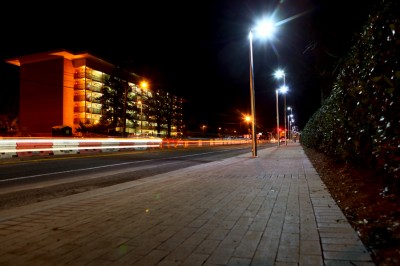
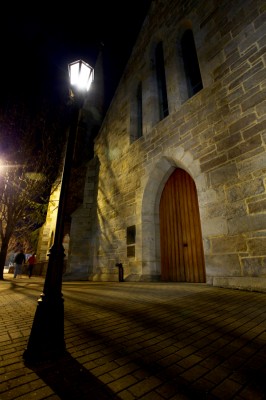
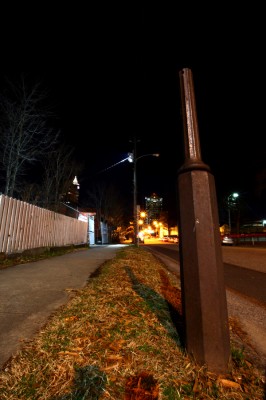
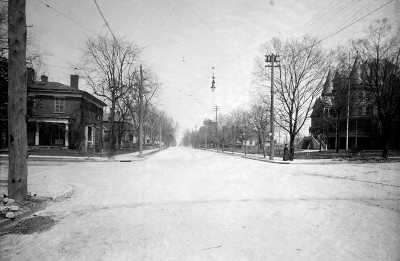
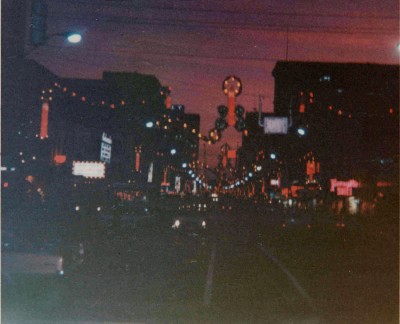
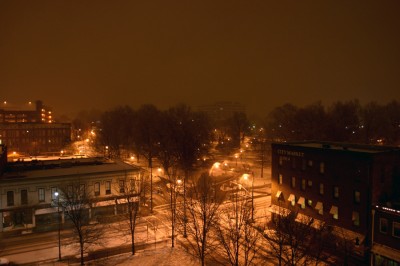
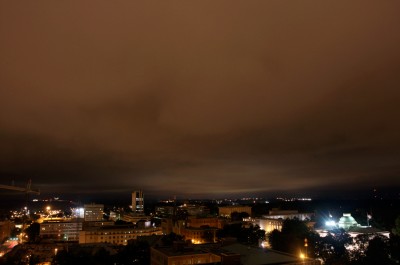
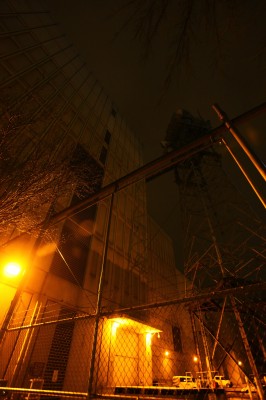
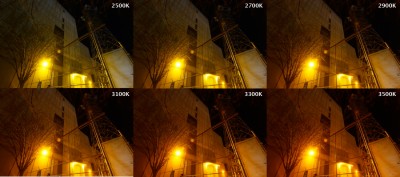
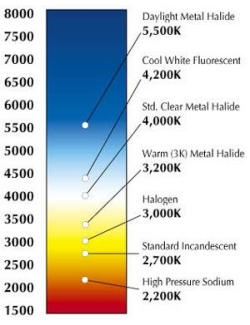
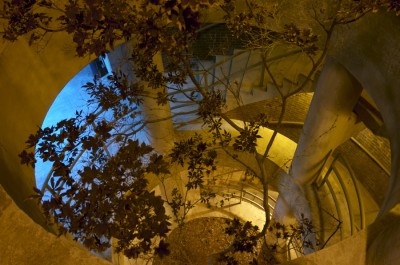
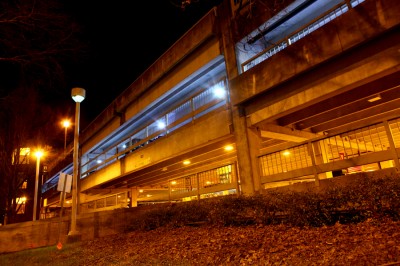
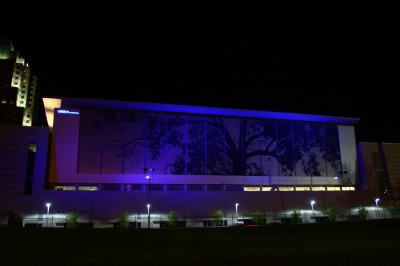
 Sign up for the Newsletter
Sign up for the Newsletter
01/29/2010
For some frame of reference about the cost of street lighting. My townhouse subdivision spends $60,000 a year on street lights. Not to replace them, not new ones, to run them. Sodium Vapor of course.
01/29/2010
Very interesting article. I tend to notice street lights more than most people. Mostly the fact that Raleigh has TONS of burned-out ones all over the city. (Seriously, it’s getting a bit embarrassing…buy some bulbs folks!)
Fortunately the new LED technology is helping alot. The lights use a ton less energy and the bulbs last longer.
You mention a downside that the ones in the city hall deck look bluish…but they are an earlier version. Check out some of the ones near the new Convention Center…they produce a much more natural white.
01/29/2010
Thanks for this trip down lighting history lane. As always, you do an incredible job giving us insight on Raleigh’s history.
I’m thrilled about LED lighting technology. As a Cree employee, I read about LED street lights, office lights, parking deck lights and even residential lights being installed all the time. It’s truly incredible to read about the energy savings that governments, universities and even business owners are seeing because they switched to LED lights.
We show off a lot of examples of LED lighting on our site and also offer a monthly photo contest for people to win 5 of our LED lights. You can see more at http://CreeLEDRevolution.com
Thanks, John, for showing off some of Raleigh’s efforts to save energy and provide its residents & visitors with better lighting!
01/29/2010
Well-done piece on evolution of street lighting. Most recent developments include induction lamps and bi-level “smarts” (that use motion sensors to achieve even greater energy savings). Also, changes to ages-old IESNA criteria may be coming eventually, reflecting a better understanding of role of scotopic vision. Lighting levels are currently set @ photopic levels (i.e. broad daylight), even though human eyes are adapted for scotopic @ night. California Lighting Technology Center (CLTC) in Davis, CA, is leading research into new products that capture advantages of these new technologies. CREE is affiliated with CLTC and is helping with the innovations.
01/29/2010
thanks john. i’d like to see this trend extend to the entire downtown area soon. my only question is, how many of these lights do i have to steal to make my giant LED TV?
01/29/2010
Truly, Raleigh is now the shining city of the future.
01/29/2010
The parking deck near the Civic Center- the Wake County Deck- had the white-ish LED lights throughout. It being a new deck- under a year old- they went with the most advanced technology they could afford. Was glad to see the county use the new technology in construction, maybe the new courthouse will utilize the newer technology as well when it’s built- just think of all the lights in a big courthouse!!
01/29/2010
Nice article, great photos.
It should be noted that light pollution is not a product of just sodium vapor, but of all light sources to some extent, and most particularly depends on how they are directed. I like the idea of LED lighting for indoor applications, and the fact that most LED fixtures I have seen are full-cutoff, I fear that a growing trend of “more light” will negate the potential reduction in light pollution. Full cutoff is only one aspect, but a distrubring trend I have seen is the increasing the lumen density of lighting installations. I have seen, many gas stations, fast food restaurants and other businesses have in recent years been drastically increasing the amount of light on their properties. As noted, its not just better street lights we should feel good about. Private property owners are the ones most likely to point lights (LED or otherwise) in such a way as to create light trespass, glare, and skyglow just as they always have, and the problem with LED is that they are brought spectrum, rather than emission line like the arc lamps (sodum vapor, mercury vapor, etc). This could actually result in far MORE light pollution than sodium or mercury lights could ever produce.
I do see a “bright” future ahead, and to me, that is a significant problem. We must learn how to use light wisely. Good lighting practice is not just dependent on what technology is used, but also in how it is used.
By the way, I’m in Providence, RI so my examples and experiences are not specific to Raleigh. I have been an amateur astronomer for over 25 years and have recently written to the local municipalities with my concerns about light pollution.
01/30/2010
A bit of trivia: The remains of an old gas plant were discovered during the excavations of ground for the construction of the convention center. A substantial reservoir of coal tar was found, and had to be removed from the site. The coal tar was either a by-product or the source fuel for the gas, depending on what process was used. This was called “coal gas”, “town gas”, or “illumination gas”.
01/30/2010
Thank you for the informative article. Lighting is one of those topics that many people will never even scratch the surface of, but it will have such a significant impact on their everyday lives. Those of us who appreciate cities with a vibrant night life notice these types of things.
One of my initial impressions when I moved to Raleigh was shock of how dark the city is at night and that they still had such poor lighting infrastructure along Hillsborough street, which is thankfully being addressed. It’s a positive sign to see the City of Raleigh being innovative and thinking ahead on this issue as well as supporting a local business.
01/31/2010
John:
Thanks for this overview of the City’s lighting program. To see our LED streetlight pilot projects so far, check out the lighting in these locations:
+ Davie Street, from Wilmington to Blount
+ RCC Block (Salisbury, Cabarrus, Lenoir, and Wilmington Streets)
+ Hillsborough Street, from Gardner to Oberlin (under construction)
02/03/2010
What I’d like to see the city do next would be to upgrade some existing light fixtures. The blocks of Hillsborough Street from Glenwood to the Capital have nice looking Victorian-style street lamps that are very appropriate for the area….BUT they are way too dim! Could the city work with Cree to upgrade those lampposts to a brighter LED bulb while still keeping the same style fixture?
01/11/2015
I really like the idea of the 6 frame building shot showing different Kelvin levels from 2500 to 3500 degrees. However it seems to me that the values are labeled backwards. On almost every Kelvin Temperature scale that I have seen on the internet, 3500 degrees would be a “whiter” color than 2500 degrees, which would be a more “yellow” color. Could it be that these values are labeled backwards on your website? If so, can you post the corrected picture? Thanks.
01/25/2015
Actually, sodium vapor lights (especially the “yellow” low pressure ones) are more energy efficient than LEDs at over 100 lumens per watt, often up to 200. There is this urban myth out there that LEDs beat all, but they don’t. They roughly match the efficiency of metal halide lamps.
The LEDs are not even safer. The wavelengths emitted by sodium vapor lamps are in a range that is ideal for actually seeing things, if not for color recognitions.
San Diego, CA didn’t even go to LEDs when switching from sodium vapor… they went to induction lighting, a new form of lighting and I can’t find any hard info on its efficiency (lumens per watt).
LEDs use more energy and are a wash on safety because you making a tradeoff between wavelength and color recognition. The argument for LEDs over sodium vapor boils down to aesthetics, which I think is a totally valid argument. But just because sodium vapor is “old” doesn’t mean it doesn’t have advantages.
Perhaps I’m just nostalgic.
07/26/2022
It’s interesting to see the push for LED lights back in 2009/2010 before the true effects of any conversion were known. We now know that blue-rich LED lights produce more light pollution, increase cancer rates in exposed populations, have negative effects on the fetal development of babies, harm eco-systems to the point of being described as “insect genocide” by scientists and on a physics level cause more glare than warmer light. Stepping outside at night feels like walking into the freezer section of a store, cold and unforgiving.
The kicker is that back in 2010 LED lights were less efficient than HPS lights, the illusion of using less energy simply came from LED fixtures lighting smaller areas than the HPS fixtures they replaced. Even in 2022 any LED that matches the spectrum and diffusion quality of HPS fixtures is on par with HPS efficiency at best. The LED lighting conversion was a scam and we’re now paying for it with reduced vision at night and detrimental effects on human and ecological health.